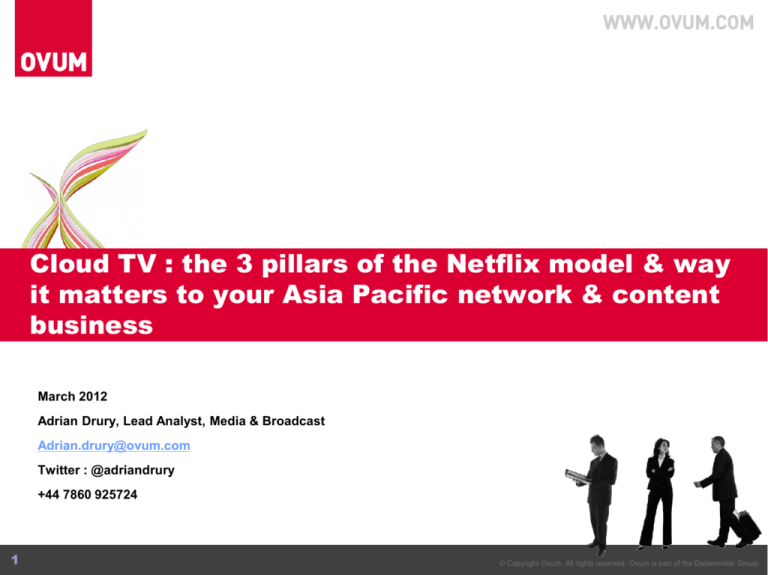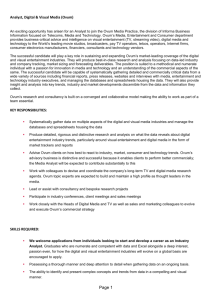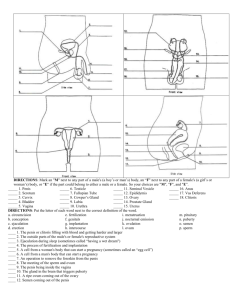
Cloud TV : the 3 pillars of the Netflix model & way
it matters to your Asia Pacific network & content
business
March 2012
Adrian Drury, Lead Analyst, Media & Broadcast
Adrian.drury@ovum.com
Twitter : @adriandrury
+44 7860 925724
1
© Copyright Ovum. All rights reserved. Ovum is part of the Datamonitor Group.
New models of video consumption vs. traditional broadcast:
US usage in perspective
Q3 US traditional linear (inc. DVR) vs. web distributed
video & mobile
240:00:00
216:00:00
12-17 & 18-24
aggregate mobile +
PC video usage > TV
timeshift (inc. DVR)
192:00:00
168:00:00
Mobile subs watching video
on a mobile phone
144:00:00
Watching Video on the Web
120:00:00
Watching traditional TV
96:00:00
72:00:00
7% growth to q3 2011 YoY
in web video viewing
(linear & non-linear)
48:00:00
24:00:00
0:00:00
Q3 2011 - Q3 2011 - Q3 2011 - Q3 2011 - Q3 2011 - Q3 2011 - Q3 2011 - Q3 2011 2 to 11 12 to 17 18 to 24 25 to 34 35 to 49 50 to 64
65+
2+
Source: Nielsen / Ovum
2
US TV homes in Nielsen
base set to decline in 2012
to 114.7M from 115.9M
driven by youth market
© Copyright Ovum. All rights reserved. Ovum is part of the Datamonitor Group.
Re-architecting the industry?
3
© Copyright Ovum. All rights reserved. Ovum is part of the Datamonitor Group.
Netflix: Strategic success factors
4
Netflix used a DVD rental-by-post model to build a subscriber base, brand
awareness, and content licensor relationships while it waited for consumer
broadband penetration and client device sophistication to reach a point at which it
could support a streaming model.
The company has a device integration model that has enabled it to go to market
with a broad range of consumer electronics device manufacturers and application
platforms without subsidizing its own CPE.
Netflix is a true “Cloud TV” platform in that rather than providing services from its
own data center assets, it has transitioned its platform to Amazon Web Services,
which enables it to scale to meet the uneven capacity requirement challenges of
providing premium HD video services in volume.
As Netflix continues to gain customers, the marginal cost per subscriber for
content acquisition reduces within the rights cycle, and Netflix has the market
power to acquire valuable content earlier in its viewing window.
© Copyright Ovum. All rights reserved. Ovum is part of the Datamonitor Group.
Netflix subscriber growth and cost-per-user fundamentals
5
Netflix is seeing a rapidly growing subscriber base against a falling ARPU as users move to
AYCE (All You Can Eat) streaming plans.
CDN (variable) and technology costs (fixed) sum to <8% of ARPU.
There is material risk in increasing cost of streaming content per subscriber.
© Copyright Ovum. All rights reserved. Ovum is part of the Datamonitor Group.
Ways to play: IP TV vs. cloud TV B2B supply chain
Media hub for postproduction assets
and business
process
outsourcing
Metadata
& archive
managem
ent
Partner, embed &
broker CDN estate
(telco + pure-play)
Play-out
operations &
headend
linear multicast services for ISP IPTV
File
transfer
services
linear multicast for future hybrid DTT platform
On-demand tVOD, sVOD,
network PVR, +7 day
Hub for
post
services
Media Asset
Management
Presentation
layer services
Play
Media
localizatio
n services
Channel, OEM or acquire OVP with
service configuration for LCN
customer requirements
Billing & ID
management
API
Content
DRM
Metadata
Video masters
CRM
Scheduling
Device
configuration
Transcoding
Ecommerce
Search
Asset selection
& control
CDN routing
Personalization
Creative
services
Aggregate, channel (and host?) for
fragmented service platform and
companion app dev market
6
App
framework
licensing
App lifecycle
management
Companion
apps
© Copyright Ovum. All rights reserved. Ovum is part of the Datamonitor Group.
Netflix cloud application platform: The new
architecture of broadcast?
Play
7
WWW
API
Logs
Content
CRM &
billing
DRM
Search
Metadata
Comms logs
Video
masters
E-commerce
CDN routing
Asset
choosing
Device
configuration
Preference
Adaptive
transcoding
Audience
analytics
Bookmarks
Ratings
Content
selection &
control
Play-out
monitoring
Archive
Campaign
management
Logging
Similars
Mobile device
& iPhone
Business
Intelligence
CDN
Preference
© Copyright Ovum. All rights reserved. Ovum is part of the Datamonitor Group.
Supply side strategic priorities: cutting operational costs, advanced
audience measurement, social integration and multi-platform distribution
The Asia-Pacific View: “Please rate the following strategic activities that are
critical to your broadcast media business”
3D production & channel launch low strategic priority, plus diversification into new pay models also a relatively low priority
thanks to strength of Asian broadcast ad markets
Source: / Ovum (n=150)
8
© Copyright Ovum. All rights reserved. Ovum is part of the Datamonitor Group.
In Asia-Pacific, centralizing operations in line with market consolidation is
the operational priority followed by production and business management
system integration
The Asia-Pacific View: “Please rate the following operational issues that are
business-critical to the future of your organization”
Upgrading IP distribution and transmission systems and enhancing production systems rank as the third and fourth
operational investment priorities for Asia-Pacific broadcasters.
Source: / Ovum (n=150)
9
© Copyright Ovum. All rights reserved. Ovum is part of the Datamonitor Group.
“Cloud TV” technology strategy
10
Netflix is a pathfinder for cloud computing across all industries, not just video
entertainment services.
Netflix has moved its entire 24×7×365 video on-demand service from its own DC
infrastructure to Amazon Web Services.
It exploits commodity computing for scale and open source for agility.
The company observed that capacity growth rate was accelerating and unpredictable, with
spikes at product launch (iPhone, Wii, Ps3, Xbox). Data centers represented a large,
inflexible capital commitment.
Why AWS: AWS investment in tooling and automation; AWS zones for high availability,
scalability; AWS development skills are increasingly easy to find.
Benefits:
Faster – lower latency than equivalent data center web pages and API calls.
Scalable – no data center capacity constraint as subscriber count increases.
Availability – greater robustness and availability (no downtime).
Agility – availability of a large developer pool and elimination of the need for complex selftooled data center code.
© Copyright Ovum. All rights reserved. Ovum is part of the Datamonitor Group.
Agile procurement of low-cost, high-performance CDN
capacity
Netflix distributes video streams to end customers via carrier/CDN agreements with Level3 and Limelight.
November 2010 began a move of Netflix’s traffic away from Akamai due to competitive bidding from both Limelight
and Level3, and alleged performance deficiencies of video on the Akamai network (albeit publicly denied by
Akamai).
Netflix CDN cost per sub pcm
($)
This follows a shift of Netflix traffic from Level3 to Akamai in February 2010, and before that, from Limelight
to Level3.
Netflix, like other providers using public IP infrastructure, is able to exploit competitive dynamics within the CDN
market to drive cost down and select the highest-performance networks for a given application class (namely video
streaming).
However, Netflix is seeing some growth in CDN cost per subscriber due to increased streams per user, although
this is marginal as a percentage of content licensing costs.
Digital delivery (CDN) / sub
0.25
0.2
0.15
0.1
0.05
0
1q 09
2q 09
3q 09
4q 09
1q 10
2q 10
3q 10
4q 10(e)
Digital delivery (CDN) / sub
11
© Copyright Ovum. All rights reserved. Ovum is part of the Datamonitor Group.
Netflix legal dispute between Level3 and Comcast
12
In November 2010, news emerged that Comcast was threatening to
block Level3, given that Level3 had secured the contract to act as a
backbone for Netflix traffic.
The detail of the dispute is a commercial disagreement between Level3
and Comcast regarding relative traffic levels contravening thresholds in
their peering arrangement.
Comcast is not explicitly throttling Netflix traffic, but seeking to offset
inbound traffic costs by raising a levy on Level3 as a Netflix carrier.
If the FCC sanctions this activity by Comcast, it may increase Netflix’s
wholesale carrier costs. However, price competition in the CDN/carrier
market may in fact push any incremental cost back to the wholesale
provider.
© Copyright Ovum. All rights reserved. Ovum is part of the Datamonitor Group.
International expansion – Canada demonstrates that
Netflix can rapidly exploit latent demand in new markets
13
Netflix has issued guidance that by the end of 1Q11, it expects to have secured 700,000–
950,000 subscribers in Canada.
Initial analyst consensus estimates were 300,000 by 4Q11.
As it moves into new markets, Netflix has the strategic advantage of being pre-integrated with
a large installed base of CE platforms, as well as having strong word of mouth among early
technology adopters.
The international footprint of AWS infrastructure will also enable Netflix to scale into new
markets with little capex overhead. This is being tested with its pending entry of Latin
America (est. Q4 2011).
The primary challenge for the company’s international expansion is content licensing for
streaming in local markets at a cost that does not have material impact on its profitability – this
is proving highly challenging.
However, when Netflix is able to secure content licensing terms for streaming in Europe (est.
1H 2012), it will introduce a major new competitive aggregator into this market, with potential
long-term material impact for FTA broadcast and Pay-TV models.
We note that there is little material effect on cable operators in the US or opportunity for
strategic response.
© Copyright Ovum. All rights reserved. Ovum is part of the Datamonitor Group.
Disruptive threats to the broadcast supply chain
Short term
Direct impact
Indirect impact
Long term
Direct
Indirect
impact
impact
Homogenised HTML / IP content delivery into
DTH / DTT / DTC systems: disruptive accelerant
Change in the EPG UI and erosion of value of
channel brand & Logical Channel Number
model
Connected TV / Console app platform
penetration, take up and share of audience
Live & non-live audience growth on non-DTT
devices
Shifting delta between DTT / DTH and DTC
transmission vs. SD & HD unicast / multicast
over IP
Cloud TV : the impact of an IaaS enabled global
rights procurment / production model
Social affinity marketing – low cost, high effect
audience acquisition tool and potential impact
on LCN value
Multi-platform audience measurement and
impact on linear broadcast ad revenue
14
© Copyright Ovum. All rights reserved. Ovum is part of the Datamonitor Group.
Non-TV applications still most popular for multi-tasking audiences
The applications used whilst watching TV can be split into two camps:
general applications that are unrelated to the content that is currently on
the TV, and TV-related applications where the user is communicating
about or interacting with the TV content in some way.
General Internet-related applications
% of people that use second-screen devices
90%
80%
TV-related applications
70%
60%
50%
40%
30%
20%
10%
0%
t
e
k
n
h
g
n
nt
M
es
in
or
rc
sit
en
tio
te
tio
/I
a
m
b
a
n
a
tw
nt
pp
e
a
e
g
o
c
ic
e
o
i
s
o
l
g
l
n
c
e
c
w
c
n
t
p
/
tti
th
d
pp
Sh
an
pr
ay
al
ne
e
TV
eo
ap
ha
es
to
de
V
ci
Pl
/a
er
id
ar
e
n
on
V
C
n
o
t
T
i
d
v
l
e
h
s
a
T
t
t
r
n
e
In
ou
s
si
ad
br
fo
io
at
ch
al
to
ty
g
es
at
ci
el
eb
at
he
er
d
r
a
c
t
n
o
i
e
w
m
s
c
s
h
t
W
s
t
r
n
w
A
w
w
s
la
fo
ca
Vo
itio
re
ne
ut
es
ho
ad
l in
et
c
o
s
s
s
o
a
p
c
w
n
ab
A
es
br
m
TV
As can be expected, general Internet applications are more
ne
tio
cc
rk
co
e
ss
s
o
di
A
h
e
e
t
s
d
w
c
n
t
e
a
i
popular than those that are linked to TV content. This is bad news
s
c
l
c
e
s
s
A
on
ln
Ac
ce
es
r
a
c
i
for content producers as such applications steal viewers’ attention
c
c
te
A
Ac
So
En
away from the TV screen. Having said that, the second-screen
nt
te
n
o
rt
ve
ad
s
m
ra
g
o
ow
sh
h
tc
wa
g
in
device is becoming a useful TV companion for finding out more
information, and networking, about the TV content.
15
© Copyright Ovum. All rights reserved. Ovum is part of the Datamonitor Group.
Crossing the ratings panel divide & breaking barriers to
transformation: the forces morphing audience relationship into
a customer relationship
Build audience &
dwell time in the Nscreen market
across core &
derivative services
Insight demand from
advertisers & use of
STB + web analytics
Broadcast &
publishing
integration –
efficiently cycle
audiences between
properties
Personalization, web
distribution & entry
of Facebook
N-screen installed
base and usage
growth
16
Advertisers buy
more audiences,
less proxy content –
rush to build option
value
Customer
iD
New trading &
entitlemement
models –
micropayment,
sVOD, rewards
© Copyright Ovum. All rights reserved. Ovum is part of the Datamonitor Group.
Smartphones driving multi-platform service usage: 67% YoY
mobile TV growth in 2010 in Europe (over WiFi/WCDMA/HSPA)
Mobile Subscribers Who Watched TV/Video On Mobile Phone Ever In
Month (000)
14,000
12,000
000s
10,000
8,000
09-Jul
6,000
10-Jul
4,000
2,000
0
14,000
EU5
U.K.
Italy
France
Germany
Spain
12,000
000s
10,000
8,000
6,000
Jul-09
4,000
Jul-10
2,000
0
Watched TV and/or
Watched any
Watched Broadcast Watched On-demand
Watched any
video on mobile
programmed mobile TV programming
video or TV
TV/video sideloaded
phone ever in month
TV/video
programming
to phone
Source: Ovum / Comscore
17
© Copyright Ovum. All rights reserved. Ovum is part of the Datamonitor Group.
Multi-tasking behaviour in Japan is strong, but not
out of line with Western markets
Over the past year there has been an
increase in press coverage on the use of
second-screen devices. However, in
reality the concept as a whole is not a
new phenomenon.
Do you use a second device to access Internet
applications while watching TV?
100%
90%
80%
% of total respondents
70%
60%
Never
At least occasionally
On a regular basis
50%
40%
The act of using a device to access
Internet services while watching TV on
another (i.e. the main TV) is already well
established in connected households.
According to Ovum’s Consumer Insights
survey, across the eight countries
surveyed by Ovum, more than 70% of
people claim to at least occasionally use a
second-screen device while watching TV,
with 37% doing so on a regular basis.
The trend is particularly strong in
emerging markets such as India, although
the universe of connected households in
such countries tends to be still weighted
by at least the early majority. All countries
show high usage. Germany is the most
conservative, but even here 27% of
people are regular second-screen users.
30%
20%
10%
0%
France
18
Germany
India
Japan
Netherlands
Spain
United
Kingdom
United
States
Grand Total
© Copyright Ovum. All rights reserved. Ovum is part of the Datamonitor Group.
What’s on the TV screen when using the second screen?
Which of the following types of shows would you most likely be watching while also using another device?
40.00%
35.00%
30.00%
25.00%
20.00%
15.00%
10.00%
5.00%
0.00%
19
In the UK, news programs are the
most common TV content genre to
be playing on the large screen
while companion devices are
being used.
Drama ranks as the second most
frequent category, followed by
documentary or factual
programming. Game show and
reality show a similar second
screen usage profile.
Audiences will be engaging with
second screen devices both
because of lack engagement with
content on the TV screen and for a
sub set, to engage with content
and services on screen.
© Copyright Ovum. All rights reserved. Ovum is part of the Datamonitor Group.
Major challenge for broadcast is audience multi-tasking – a
greater threat to spot engagement than DVR?
US Connected Devices - Situational Usage
80%
Situations devices used
70%
60%
50%
40%
30%
20%
10%
0%
Tablet
20
eReader
Smartphone
Watching TV
Lying in Bed
With Friends/Family
Waiting for something
In the bathroom
Attending a Meeting/Class
Shopping/Running errands
Commuting
Other
© Copyright Ovum. All rights reserved. Ovum is part of the Datamonitor Group.
Strategic framework hypothesis for broadcast
21
Near Term:
Defend a your existing channels of distribution and limit the impact of IP on your existing DTT. DTH,
DTC platforms
Exploit new low cost distribution channels for diaspora reach (IP delivery of live & non-live into
secondary app platforms and primary hybrid DTT platforms) to primary & secondary set
Extend reach of live and non-live to growing non DTT/DTC/DTH device base & audience –
particularly for secondary set viewing
Exploit social media to tactically drive ratings
Establish companion screen position & application framework strategy
Potential near term discontinuity event changing TV UI model – Apple TV as “MegaiPad”
Mid-term:
Create NHK as a global portal for media localised Japanese content – fast follow the BBC Worldwide
strategy
NHK technology strategy: will DTT have another technology iteration? Or will 8K be distributed via IP
multicast? (fixed or wireless)
Long term:
Will the audience share of linear broadcast platforms (DTT, DTH and DTC) decline to the level that
the infrastructure costs can no longer be supported?
If yes – what is the timing?
© Copyright Ovum. All rights reserved. Ovum is part of the Datamonitor Group.
Operational pain-points
22
© Copyright Ovum. All rights reserved. Ovum is part of the Datamonitor Group.
Supply side strategic priorities: cutting operational costs, advanced audience
measurement, social integration and multi-platform distribution
The European View: “Please rate the following strategic activities that are
critical for your broadcast media business”
Entry into new markets or consolidation in existing markets via acquisition
Greater exploitation of social media for traffic / audience acquisition via
social media portals and integration into live broadcast
Launch subscription VOD services
Leveraging content brands/assets into mobile content applications such as
gaming, gambling and competitions
Advanced audience measurement and targeted advertising initiatives
Production of 3D content and/or launch of 3D channels
Syndication or creation of own branded service through aggregated
broadcast video portal (eg. Youtube, Hulu)
Production of HD content and/or launch of HD channels
Reduction in operational cost through shift to file based workflow and
automation
Multi-screen services - distribution to PC, mobile, broadcast, OTT, tablet
Off-set at-risk broadcast advertising revenues by move into pay-TV
services
0%
Not an important business consideration
20%
Non-critical
40%
Important
60%
80%
100%
Critical investment area
Source: / Ovum (n=150)
23
© Copyright Ovum. All rights reserved. Ovum is part of the Datamonitor Group.
In Europe upgrading IP distribution & transmission capabilities, and
upgrade to HD operations is a priority in line with the global trend
The European view: Please rate the following operational issues that are business critical to the future
of your organization (respondents are CIOs and broadcast technology decision makers)
Upgrade systems to support industry standards (BXF/MXF) or IT protocols
(SOA)
Streamline and outsource production or business operations
Improve monitoring systems for quality assurance and regulatory compliance
Improve business management and analytics systems
Upgrade contribution and control systems for 3D operations
Enhanced content asset management & head-end systems for multi-platform
distribution
Integrate production and IT/business management & sales systems
Centralize operations
Enhance production systems (news desk, outside broadcast, sports)
Upgrade DTT/DTH/cable distribution & transmission capabilities
Upgrade IP distribution & transmission capabilities
Upgrade infrastructure for HD /3Gbps operations
Source: / Ovum
(n=150)
Not an important business consideration
0%
10% 20%
Non-critical
30%
40% 50%
Important
60% 70% 80% 90%
Critical investment area
100%
In Europe enhancing production systems, enhancing content asset management for multiplatform distribution
and integrating IT and business management systems trend relatively above the global mean. Investment in
upgrade to 3D operations in a weak priority.
24
© Copyright Ovum. All rights reserved. Ovum is part of the Datamonitor Group.
Consumer media consumption
trends
25
© Copyright Ovum. All rights reserved. Ovum is part of the Datamonitor Group.
Smartphones driving multi-platform service usage: 67% YoY
mobile TV growth in 2010 in Europe (over WiFi/WCDMA/HSPA)
Mobile Subscribers Who Watched TV/Video On Mobile Phone Ever In
Month (000)
14,000
12,000
000s
10,000
8,000
09-Jul
6,000
10-Jul
4,000
2,000
0
14,000
EU5
U.K.
Italy
France
Germany
Spain
12,000
000s
10,000
8,000
6,000
Jul-09
4,000
Jul-10
2,000
0
Watched TV and/or
Watched any
Watched Broadcast Watched On-demand
Watched any
video on mobile
programmed mobile TV programming
video or TV
TV/video sideloaded
phone ever in month
TV/video
programming
to phone
Source: Ovum / Comscore
26
© Copyright Ovum. All rights reserved. Ovum is part of the Datamonitor Group.
Major challenge for broadcast is audience multi-tasking – a
greater threat to spot engagement than DVR?
US Connected Devices - Situational Usage
80%
Situations devices used
70%
60%
50%
40%
30%
20%
10%
0%
Tablet
27
eReader
Smartphone
Watching TV
Lying in Bed
With Friends/Family
Waiting for something
In the bathroom
Attending a Meeting/Class
Shopping/Running errands
Commuting
Other
© Copyright Ovum. All rights reserved. Ovum is part of the Datamonitor Group.
Multi-tasking doesn’t just mean social, it also means
alternative video services, gaming and app usage
What are consumers doing on their tablet devices?
40.00%
37.70%
36%
35.00%
30.00%
23.60% 23%
25.00%
21.59%
20.00%
17%
14.58%
14.52%
15.00%
11.50%
10.20%
10.00%
5.00%
0.00%
Web browsing
Source: Ovum
Using email, Facebook,
Twitter and/or other
communication
Watching video
Nov-10
Playing games
Using other apps
May-11
Social media – the perfect water-cooler but also the first significant substitute for broadcast ad
spend.”
28
© Copyright Ovum. All rights reserved. Ovum is part of the Datamonitor Group.
Ovum pay-TV consumer demand behaviour insights
29
Penetration of multi-channel TV services is high across all platforms, exceeding 100% of broadbandequipped households in all countries. Free-to-air (FTA) digital terrestrial television (DTT) has been a
key driver of multi-channel TV uptake in markets such as Australia, France, Spain, and the UK by
virtue of its low adoption costs, while subscription-based cable and/or satellite pay-TV platforms
have led growth in Brazil, India, and the US, as well as to some extent the UK. Adoption of multiroom digital TV services is also prevalent in most homes, accounting for nearly half of all cable and
DTT installations as well as around 40% of satellite subscriptions. Uptake of pay-TV versus FTA
services varies widely between countries and is largely determined by the success of DTT relative to
other platforms within a given market.
The public Internet is rapidly gaining traction as a credible distribution platform for a range of content
that includes broadcasters’ catch-up TV, premium TV shows, and movies, as well as short-form
clips, which remains the biggest online video category. Internet TV and video is finding its way to
connected TVs, games, consoles, set-top boxes, smartphones, and tablets, with content types and
use cases varying according to the nature and capabilities of each type of device. Despite the
industry hype, however, penetration of both tablets and Internet-connected TV sets remains low, with
consumption of popular online content services such as BBC iPlayer, Hulu, and Netflix still taking
place mostly via PCs and laptops.
The use of personal computers, mobile phones, and portable media players (still predominantly
comprising of Apple’s iPad and iPod Touch) as companion devices for viewing video content while
simultaneously watching TV remains at a nascent stage, although usage levels indicated in the
survey aren’t insignificant and will only grow as consumer behavior continues to evolve. We are
already seeing substantial usage of social media concurrent with TV viewing, with a proportion of
consumers showing a propensity for social TV by engaging in contextually relevant social
interactions. Although it’s still early days, tablets are showing almost equal appeal across all age
bands, whereas the use of personal computers and mobile phones for activities such as companion
viewing and social media is lower among older users.
© Copyright Ovum. All rights reserved. Ovum is part of the Datamonitor Group.
Relative scale of TV service platform adoption
Penetration of multi-channel TV platforms
DTT is the most widely deployed TV
distribution platform in most developed
markets apart from the US and
Germany, where cable and satellite
continue to dominate the multi-channel
landscape.
Satellite remains a strong pay-TV
platform in the both UK and US, as well
as enjoying rapid growth in laterdeveloping markets such as Brazil and
India.
The continuing popularity of retail freeto-air equipment accounts for satellite’s
continuing strength in Germany.
IPTV remains an underdog within the
competitive landscape of TV
distribution platforms in all countries
except France, where a weak cable
sector and a stagnant satellite pay-TV
market created openings for both IPTV
and DTT, which have grown in tandem,
with many households using hybrid settop boxes (STBs) that combine both
technologies. In all countries, multichannel TV installations exceeded the
number of respondents, indicating an
average 145% household penetration of
multi-channel TV installations.
30
© Copyright Ovum. All rights reserved. Ovum is part of the Datamonitor Group.
Multi-room TV penetration
TV platform installed base: single room vs. multi-room
The availability of low-cost retail STBs and free
access to content have driven DTT penetration,
making it a major multi-room digital TV platform.
But multi-room subscriptions are also a key valueadded enhancement and revenue generator for
multi-channel pay-TV providers such as BSkyB,
ComCast, DIRECTV, and Verizon. As of 1Q11, BSkyB
had 2.2 million multi-room subscriptions (equal to
around 22% of its TV customer base), for which it
charges an additional £10.25 per month.
Multi-room TV penetration by platform
90%
80%
70%
60%
50%
40%
30%
20%
10%
0%
31
IPTV
Satellite
Cable
Digital terrestrial
Although single-room multi-channel TV
installations are proportionally higher than
multi-room in most countries, the US is a
major exception, with multi-room
exceeding single-room across all
platforms – by a factor of three in the case
of cable and satellite and two in the case
of IPTV. DTT installations in the UK are
equally split between single and multi-room
while multi-room DTH in Spain is double
that of single-room.
© Copyright Ovum. All rights reserved. Ovum is part of the Datamonitor Group.
Multi-channel TV adoption: pay-TV versus free-to-air
Our sample is broadly split 50/50
between FTA and pay-TV, although
service adoption varies widely
between countries. The US and UK
have the highest pay-TV penetration
levels across their total base of
consumer households, driven by the
strong established presence of cable
and satellite operators. Pay-TV is
also making headway among the
higher-income segments in Brazil and
India (to which our samples are
biased). Australia, France, Japan, and
Spain, each with strong terrestrial TV
markets, are more typical of the
global pay-TV/FTA split, while
Germany’s low propensity towards
paid services reflects the country’s
continuing preponderance of both
FTA satellite and utility cable
services.
Spread of TV service types
Grand total
US
UK
Spain
Japan
India
Germany
France
Brazil
Australia
0%
32
20%
40%
60%
80%
100%
Free TV channels only
Extended basic package
Basic pay-TV package
Full premium
© Copyright Ovum. All rights reserved. Ovum is part of the Datamonitor Group.
What keeps consumers paying for TV services?
Content choice and quality are the most important
pay-TV purchasing decision criteria, with little
variation between countries in the proportion of
consumers citing these two factors. One exception
is Japan, where 70% of consumers valued the
range of content available from pay-TV services.
Why do you continue to pay for a monthly TV
subscription?
It offers a better range of content than any
other single provider
40%
It offers the best quality of content
28%
My TV service is bundled with my
broadband and/or fixed telephone service at
a reduced subscription
25%
I believe my TV service provider provides
a higher quality of service than
subscription-free alternatives
Perhaps surprisingly, QoS isn’t what keeps the
majority of customers paying for their TV services.
This, along with an almost unanimously low ranking
of perceived value for money as a pay-TV driver,
suggests untapped opportunities for service
providers to differentiate more aggressively on user
experience rather than simply focusing on content.
23%
I believe my TV service provider offers
better value for money than subscriptionfree alternatives
The prevalence of triple-play bundling varies
markedly between different multi-channel markets.
Those dominated by pure-play satellite services
(e.g. Germany and India) have fewer bundled
service customers, while those with well-established
cable or IPTV operations that offer discounted multiservice packages (e.g. France, Spain, the US) have
more.
15%
0%
10%
20%
30%
40%
% of respondents taking
pay-TV services
33
© Copyright Ovum. All rights reserved. Ovum is part of the Datamonitor Group.
Internet TV
Consumption of TV-related content on connected devices
90%
80%
PC/laptop
70%
60%
Mobile phone
50%
40%
Portable media device
such as an iPad/iPod
Touch
TV connected to the
Internet
30%
20%
10%
0%
Access Watch short Watch TV Watch fullnews
videos from episodes length films
headlines/ sites such from sites
content as YouTube such as
Hulu
Short-form video (as distributed via sites such
as YouTube) remains the most common video
content category being consumed online,
although consumption of TV shows is growing
with the success of services such as Hulu in
the US and the various broadcasters’ catch-up
TV services in markets such as France and the
Don’t use that application
UK. Still, with just 10% of consumers actually
subscribing to paid TV or movie services
online, there’s still plenty of room for growth in
this area.
Consumption of TV-related content on secondary devices is high with 87%,
84%, 51%, and 47% of consumers accessing news, video clips, TV shows,
and movies respectively on their PCs, phones, portable media devices, or
connected TV sets. Respondents saying they consumed these content types
on a TV connected to the Internet include those using Internet-enabled set-top
boxes and games consoles as well as directly connected TV sets. It should be
noted that the indicator for the news content category above includes all types
of media and not only video.
34
The PC/laptop is still the most widely used
device for consuming Internet-sourced content.
Despite the booming popularity and increasing
video-related capabilities of smartphones, they
are still being used by only a minority of
consumers for video consumption and most if
this is video clips.
The proportion of responses indicating
consumption of long-form video via a TV
connected to the Internet shouldn’t be
underestimated, given the still-low penetration
of both directly connected sets and Internetenabled STBs.
© Copyright Ovum. All rights reserved. Ovum is part of the Datamonitor Group.
Ovum : Multi-tasking insights
35
The use of connected devices while also watching the TV (second-screen activity) is on the increase. According to Ovum’s
survey, more than 70% of people in connected households (i.e. those living in a household that has broadband access of some
kind) claim to at least occasionally use a second-screen device while watching TV, with 37% doing so on a regular basis.
People living in Germany tend to be slightly more conservative with regards second-screen usage, but overall the trend is fairly
consistent across all countries.
Most of the activity consists of simply accessing the Internet on a connected device, with the TV also happening to be on in the
background. Standard Internet trends therefore apply – the main one being that younger age groups are the most active users.
This weighting towards the younger segment of the population impacts the demographics of the typical second-screen user. For
example, they are more likely to be single or living with a partner, and if single, still living at home with their parents or with
friends. There is no significant difference between the genders though – females are as likely to be regular second-screen
users as males.
Smartphones and tablets are increasing in popularity as a way of connecting to Internet services and applications, and make
ideal second-screen devices. However, although device adoption is rapidly increasing, only a percentage of mobile handsets
are currently connected to Internet services and applications, and tablets still have a low market penetration. The PC/laptop
remains the most popular connected device and is therefore also the most popular second-screen device, even among the
young. Ovum expects second-screen usage to swing in favour of the smartphone over time as overall device penetration
increases. The use of tablets (which are not as heavily weighted towards the young) as companion devices will also increase,
although at a slower rate than the smartphone.
As can be expected, standard Internet usage habits don’t change simply because the user is also watching TV. However, there
are a growing range of TV-related applications and activities that are starting to gain popularity - especially those providing
access to further information / news and social interactions about the TV content. In terms of social media, the general social
networking platforms remain more popular among regular consumers than the specialist social TV platforms such as GetGlue.
News is the most likely TV genre to be on the main TV when people are using a second-screen device. This is also true when
the second-screen activity is linked to the TV content. Gameshows, reality TV, and TV dramas are also popular TV genres for
this type of activity.
Watching alternative TV/video content on the second screen is a significantly popular activity, especially among the young. A lot
of such viewing is not related to the TV content on the main TV screen, suggesting that, at least while watching certain content
genres, the user may have lost interest in what is happening on the main screen. Although most alternative video viewed on
companion devices is short-form content, nearly a third of users are watching second-screen video content for more than five
minutes at a time.
© Copyright Ovum. All rights reserved. Ovum is part of the Datamonitor Group.
Over 70% of connected people access the Internet while watching TV
Over the past year there has been an
increase in press coverage on the use of
second-screen devices. However, in
reality the concept as a whole is not a
new phenomenon.
Do you use a second device to access Internet
applications while watching TV?
100%
90%
80%
% of total respondents
70%
60%
Never
At least occasionally
On a regular basis
50%
40%
The act of using a device to access
Internet services while watching TV on
another (i.e. the main TV) is already well
established in connected households.
According to Ovum’s Consumer Insights
survey, across the eight countries
surveyed by Ovum, more than 70% of
people claim to at least occasionally use a
second-screen device while watching TV,
with 37% doing so on a regular basis.
The trend is particularly strong in
emerging markets such as India, although
the universe of connected households in
such countries tends to be still weighted
by at least the early majority. All countries
show high usage. Germany is the most
conservative, but even here 27% of
people are regular second-screen users.
30%
20%
10%
0%
France
36
Germany
India
Japan
Netherlands
Spain
United
Kingdom
United
States
Grand Total
© Copyright Ovum. All rights reserved. Ovum is part of the Datamonitor Group.
Multi-tasking is a habit of the young especially
90%
…by age
80%
% of total respondents
70%
60%
50%
Never
At least occasionally
On a regular basis
40%
30%
20%
10%
0%
16-24
25-34
35-44
45-54
55+
At a high level, second-screen usage consists
of accessing Internet applications, but simply
doing so while watching TV. It is therefore
unsurprising that this activity follows the same
trends as standard Internet access when it
comes to demographic indicators, the most
important of which are those based on age.
As with most things to do with the Internet, the
younger population tends to lead the way.
Nearly 85% of 16–24 year-olds in connected
households use devices in this way at least
occasionally, 45% on a regular basis. The trend
drops off as we move into the older segments.
Even here, over 55% of 55 year-olds are at
least occasional users.
90%
80%
…by gender
70%
% of total respondents
60%
50%
Female
Male
40%
30%
20%
10%
This weighting towards the younger segments
of the population does impact the typical
second-screen user demographic. For
example, people who are single or living with a
partner are more likely to use second-screen
devices than those who are married, separated
or widowed. Similarly, people living with friends
or with their parents are heavier users than
those that live alone – largely because these
are all traits of the younger generation.
There is no significant difference in secondscreen usage between genders, either for
occasional or regular users. Females are as
likely to use second-screen devices as males.
0%
Never
37
At least occasionally
On a regular basis
© Copyright Ovum. All rights reserved. Ovum is part of the Datamonitor Group.
The PC/laptop remains popular as a multi-tasking device
90%
% of people that own such a connected device
80%
Do you use the following connected devices to access
Internet applications whilst also watching TV?
70%
60%
16-24
25-34
35-44
45-54
55+
Grand Total
50%
40%
30%
20%
10%
0%
% of people that use the device for Interent access
80%
Laptop
PC/latop
Mobile Phone
Tablet PC
70%
The PC/laptop is still the most widely used connected device.
According to Ovum’s survey, over 99% of people that have
access to a connected PC/laptop use it for popular Internet
applications such as search, email, social networking etc.
This compares to 74% of people that own a connected
mobile phone.
It follows therefore, as shown in the top chart, that the
PC/laptop remains the most popular second-screen device
among the overall consumer population. Mobile phones and
tablet devices generate similar levels of second-screen
usage, but with the handset proving more popular with
younger age groups.
However, this is not a fare reflection of the market, as as
stated above, not all smartphones are yet used for accessing
Internet services and applications. As a percentage of only
connected devices by device type therefore, as shown
opposite, the mobile phone becomes the most popular
second screen device.
60%
50%
40%
This suggests that as mobile handsets become more
connected, and therefore more widely used for Internet
applications, they will take over the PC/laptop as the most
used second-screen device overall.
30%
20%
10%
0%
Laptop
PC/latop
38
Mobile Phone
Tablet PC
© Copyright Ovum. All rights reserved. Ovum is part of the Datamonitor Group.
Non-TV applications still most popular for multi-tasking audiences
The applications used whilst watching TV can be split into two camps:
general applications that are unrelated to the content that is currently on
the TV, and TV-related applications where the user is communicating
about or interacting with the TV content in some way.
General Internet-related applications
% of people that use second-screen devices
90%
80%
TV-related applications
70%
60%
50%
40%
30%
20%
10%
0%
t
e
k
n
h
g
n
nt
M
es
in
or
rc
sit
en
tio
te
tio
/I
a
m
b
a
n
a
tw
nt
pp
e
a
e
g
o
c
ic
e
o
i
s
o
l
g
l
n
c
e
c
w
c
n
t
p
/
tti
th
d
pp
Sh
an
pr
ay
al
ne
e
TV
eo
ap
ha
es
to
de
V
ci
Pl
/a
er
id
ar
e
n
on
V
C
n
o
t
T
i
d
v
l
e
h
s
a
T
t
t
r
n
e
In
ou
s
si
ad
br
fo
io
at
ch
al
to
ty
g
es
at
ci
el
eb
at
he
er
d
r
a
c
t
n
o
i
e
w
m
s
c
s
h
t
W
s
t
r
n
w
A
w
w
s
la
fo
ca
Vo
itio
re
ne
ut
es
ho
ad
l in
et
c
o
s
s
s
o
a
p
c
w
n
ab
A
es
br
m
TV
As can be expected, general Internet applications are more
ne
tio
cc
rk
co
e
ss
s
o
di
A
h
e
e
t
s
d
w
c
n
t
e
a
i
popular than those that are linked to TV content. This is bad news
s
c
l
c
e
s
s
A
on
ln
Ac
ce
es
r
a
c
i
for content producers as such applications steal viewers’ attention
c
c
te
A
Ac
So
En
away from the TV screen. Having said that, the second-screen
nt
te
n
o
rt
ve
ad
s
m
ra
g
o
ow
sh
h
tc
wa
g
in
device is becoming a useful TV companion for finding out more
information, and networking, about the TV content.
39
© Copyright Ovum. All rights reserved. Ovum is part of the Datamonitor Group.
Smartphones and tablets increasingly used for social networking
% of people that use second screen devices
90%
80%
70%
60%
50%
PC/Laptop
mobile
Tablet
40%
30%
20%
10%
h
he
ga
ad
et
m
wo
lin
es
es
rk
W
sit
/c
a
e
tc
on
su
h
te
vid
ch
nt
eo
as
co
Fa
nt
ce
en
bo
t
ok
/T
wi
tte
Ch
r
at
tin
g
/I
M
Sh
op
pi
ng
ea
rc
ai
l
Pl
ay
et
s
Em
Ac
ce
ss
ne
ws
Vo
tin
In
te
rn
in
f
rt
ad
ve
on
al
ad
di
ti
Ac
c
es
s
so
ci
al
n
Ac
ce
ss
Ac
ce
ss
TV
re
la
te
d
ne
w
s
or
g
m
En
fo
at
rT
te
io
n
ro
V
So
pr
nl
in
ci
o
g
al
e
ra
TV
ne
m
s
tw
co
or
m
k
p
Ac
ab
et
itio
ce
Ac
ou
ss
n
tT
ce
ss
th
V
e
c
br
o
TV
nt
oa
en
dc
sh
t
ow
as
te
w
Ac
rb
eb
ce
ra
si
nd
ss
te
ed
so
ci
w
al
eb
TV
sit
e
ap
pl
ica
tio
n
0%
40
Personal connected devices
such as smartphones and tablets
will increasingly be used as
second-screen devices. It is
important therefore to track
trends on these devices to
assess whether they will change
user behaviour. As shown in the
chart, current trends across the
different device types are not too
dissimilar.
A common trend across all
devices is the increased use of
social networking platforms for
communication – including
interactions about content.
Smartphones and tablets are
more convenient than PCs or
laptops and are ‘always-on’ by
nature.
They are becoming popular
devices for social networking as
they sit well with the bursty
nature of social traffic. Therefore
although PCs and laptops
remain popular today,
smartphones (especially given
their market penetration),
followed by tablets, are likely to
become the second-screen TV
companion devices of the future.
© Copyright Ovum. All rights reserved. Ovum is part of the Datamonitor Group.
What’s on the UK TV screen when using the second screen?
Which of the following types of shows would you most likely be watching while also using another device?
40.00%
35.00%
30.00%
25.00%
20.00%
15.00%
10.00%
5.00%
0.00%
41
In the UK, news programs are the
most common TV content genre to
be playing on the large screen
while companion devices are
being used.
Drama ranks as the second most
frequent category, followed by
documentary or factual
programming. Game show and
reality show a similar second
screen usage profile.
Audiences will be engaging with
second screen devices both
because of lack engagement with
content on the TV screen and for a
sub set, to engage with content
and services on screen.
© Copyright Ovum. All rights reserved. Ovum is part of the Datamonitor Group.
What people do via social networks while watching TV
Social networking in general continues to
increase in popularity and is a regular activity
for second-screen users. Social networking
can provide a powerful tool for stimulating
interactivity and debate both between
producers and viewers – and among the
viewers themselves. However, the majority of
social media interactions running
concurrently with TV viewing remain totally
unrelated to the content and consist mainly of
people updating their own status or
communicating with friends.
45%
40%
35%
30%
25%
20%
15%
16-24
25-34
35-44
45-54
55+
Grand Total
10%
5%
0%
Update your
status
42
Have
conversations
with friends
Share content
(e.g. photos,
music files or
video clips)
Play games
Other
© Copyright Ovum. All rights reserved. Ovum is part of the Datamonitor Group.
Second-screen video consumption while multi-tasking
90%
80%
Does this video viewing session on your second
screen tend to be related to what you're
watching on TV?
70%
60%
50%
Yes
No
40%
30%
20%
10%
Watching alternative video is an
increasingly popular activity among
second-screen users and in most
cases indicates a lack of attention
towards the main TV screen. More
than 75% of people stated that the
video content viewed on their
companion devices was unrelated to
the programme running on the main
TV screen.
0%
16-24
60%
50%
40%
30%
25-34
35-44
45-54
55+
Most viewing via companion devices
still tends
How long do you watch videos for on the second screen while also watching
TV? to be of short-form video –
with sessions lasting on average
between 1 and 5 minutes, although
almost a third (32%) of secondscreen video viewers are turning their
16-24
25-34
attention away from the TV for
35-44
periods greater than this.
45-54
55+
20%
10%
0%
Less than a minute
43
Between 1 and 5 mins
more than 5 mins
© Copyright Ovum. All rights reserved. Ovum is part of the Datamonitor Group.
Q&A
44
© Copyright Ovum. All rights reserved. Ovum is part of the Datamonitor Group.







